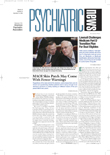In the past 15 years or so, there has been a change in social form that is impacting virtually everyone, including psychiatrists.
It is a change from hierarchies, which dominated most of the 20th century, to social networks, which are much more decentralized organizations in which people come together to share knowledge.
So argued Janice Stein, Ph.D., a professor of political science at the University of Toronto and a television commentator, at the annual meeting of the Canadian Psychiatric Association in Vancouver in November. Her talk was titled “Changing the Fabric of Social Networks: Local and Global Consequences.”
“We are moving away from an era that emphasized order and control” to one of “dispersed networks,” said Stein. We are moving away from an era of rules, of “how the game is played,” to less predictability.
One of the reasons for this shift, Stein said, is technology. For example, the Internet, which was created by Pentagon researchers, has only been commercially available since 1995.
This trend is presenting itself in a number of negative ways, she continued. For example, in the 20th century, there were specific, visible enemies to combat—say, Nazi Germany or the Soviet Union. Today, the enemies are “terrorists,” who are linked by social networks and hard to identify.
Moreover, the enemy now is us—people in communities who are alienated and angry. “It's as if we are turning against ourselves,” Stein asserted. “As psychiatrists, think about how frightening that is.”
For example, recently Stein visited France during an explosion of unrest and violence in various ethnic communities. “It is a much more frightening place than North America,” she said.
“Terror has no boundaries. That is what makes it so frightening for people... .Threats are free-floating. That is not something you would recommend for mental health.”
Nonetheless, the shift toward “dispersed networks” has some positive aspects, Stein continued. For example, Doctors Without Borders networked with the United Nations and pharmaceutical companies to bring medications to AIDS victims in Africa. A group of researchers at the University of Toronto developed a product called Sprinkles to eradicate iron deficiency in infants. Various nongovernmental organizations have helped distribute the product in developing countries, where it is helping numerous infants.
Stein foresees this trend away from hierarchies and toward networks as continuing for at least the next decade. She also recommends ways people should conduct their lives under this new social network system.
For instance, it will be very important to find good people, step back, and not micromanage what they are doing—that is, to have a “capacity to enable people” rather than to direct and control them. It is the same for raising one's children—enabling them, but not managing them. And it is similar for psychiatrists—they too should try to enable rather than manage their patients, although it will not always be easy, since this is a time when fear is rife.
Also at this juncture, Stein said, people who are willing to take risks will be very important to society, as will those who are capable of crossing over to neighboring disciplines. Most of the problems that need solving today involve not one discipline, but numerous ones; this is evident in neuroimaging and psychopharmacology.
Whereas accountability may have been an asset in a hierarchy, it is less so in a social network environment. Here, we should be more concerned about responsibility. “If we are locked into accountability and structure and hierarchy,” we will not do well in a world that is more difficult to navigate than the former one was.
Yet, “there is a huge opportunity now,” Stein concluded. This is an age that will give us more autonomy, a greater chance to experiment, a greater chance to create, and a greater chance to be responsible. ▪
